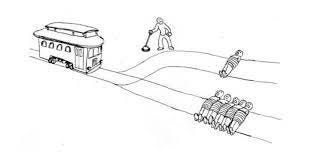A Series of Suitcase(s) Against Deontology
Plausible verdicts demand we push people off bridges
For a totally different approach to suitcase cases, but one that poses extremely difficult challenges for deontology, see here. This is one of the best papers I’ve read in a long time, but it has nothing to do with what I’ll talk about in this article, beyond both being about suitcases.
There’s a popular version of the trolley problem called Bridge. In Bridge, there is a large man on a bridge, and you can push him off to stop a train which would otherwise kill five people. Here, I’ll walk through a series of permissible actions, each one becoming more and more like the bridge scenario, until we get to Bridge. This should show that pushing men off bridges to stop trains is okay!
Scenario 1: Screaming suitcase: There are five people on a track and one person atop it. They’re all in suitcases, so they can’t see where they are. However, they’re all shouting “push the person atop the bridge off.” (After all, this leaves them each with a 5/6 chance of survival rather than a1/6 chance of survival).
In this case, it seems like you should push the person off the bridge. The Kowalczyk paper has more on this.
Scenario 2: Silent suitcases: There are five people on the track and one person atop it. They’re all in suitcases, which block sound. You don’t know what they’re saying. However, you assume that if you asked them currently, they’d want you to push the person atop the bridge off. Should you push them? This case seems to yield the same judgment as the last one—you should push them.
Scenario 3: Silent suitcases: There are five people on the track and one person atop it. They’re all in suitcases, which block sound. You don’t know what they’re saying. However, you assume that if you asked them currently, they’d want you to push the person atop the bridge off. However, they have the ability to burrow for 30 seconds, and then they’d find out if they’re in the suitcase at the top of the bridge or on the tracks. Thus, currently they’d like you to push the person off the bridge, but after 30 seconds, only five of them will have that preference. In this case, it seems like you should push them—this scenario seems analogous to the previous one, you should push them.
Scenario 4: Backs turned: There is one person atop a track and five people on it. They have their backs turned and don’t remember if they’re on the top of the track or on the bottom of it. Thus, if you asked them immediately, they’d probably all vote for you to push—though they have tape covering their mouth. Should you push the person atop the track?
This scenario seems structurally identical to the third one—the only difference is that in one case to find out whether they’re atop the bridge or on it they need to do a 30 second procedure, and in the other they need a five second procedure. But this scenario seems analogous to regular bridge.
What do people think? Any points at which you’d stop pushing people off bridges?




I'd stop at one. This seems like the obvious thing for a non-utilitarian to say, no? If the five people weren't in suitcases, then this would just be the standard footbridge case, where pretty much every deontologist is going to say that you shouldn't push the person. The fact that the people are in suitcases, and that they're willing to play the odds and hope that somebody else will be the one pushed, doesn't seem to change this at all.
I don't have the intuition that you should push in scenario 1 (and therefore of course also not in scenarios 2-5), the categorical imperative applies even if everyone involved, from a self-interested point of view, doesn't want it to apply - that's just a logical consequence of Kantianism. Although I grant that arguments from a veil of ignorance are the best arguments in favour utilitarianism.